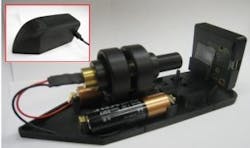Lens-free, dual-mode microscope enables low-cost diagnostics
Researchers at the University of California at Los Angeles (UCLA) (Los Angeles, CA, USA) have built a lens-free, dual-mode holographic microscope that can image specimens using both in-line transmission and off-axis reflection holography.
The prototype of the microscope has a spatial resolution in both modes of less than two micrometers -- comparable to that achieved by bulkier microscopes with low- to medium-power lenses. Uniquely, however, it only weighs around 200 g and can be powered by two AA batteries.
While the transmission mode of the microscope can be used to probe relatively large volumes of blood or water, the off-axis holography reflection mode can image denser, opaque samples. Here, a beamsplitter is used to interfere with a tilted reference wave with reflected light from an object’s surface, creating an off-axis hologram of the specimen on a CMOS sensor.
According to Aydogan Ozcan, an associate professor of electrical engineering and bioengineering at UCLA, doctors could use the lens-free microscope to improve health care in remote areas of the world where there is little access to expensive diagnostic equipment.
Part of the reason for that is that each component part of the microscope is relatively inexpensive. The laser light could be sourced for as little as $5, while the sensor used to capture the images could cost less than $15. Thus, the researchers believe that the cost of the entire system could be less than $100.
Although the microscope can capture raw data, a computer is still required to reconstruct the images from it. To do so, workers in the field could use their laptops to process the information or send it over the Internet or mobile phone networks to a remote server. Mobile phones could also have sufficient processing power to do the analysis on the spot.
The next steps for Ozcan’s team include commercializing the system. To do so Ozcan has founded a company to make a version that can be manufactured and sold to healthcare workers and hobbyists.
-- Posted byVision Systems Design
